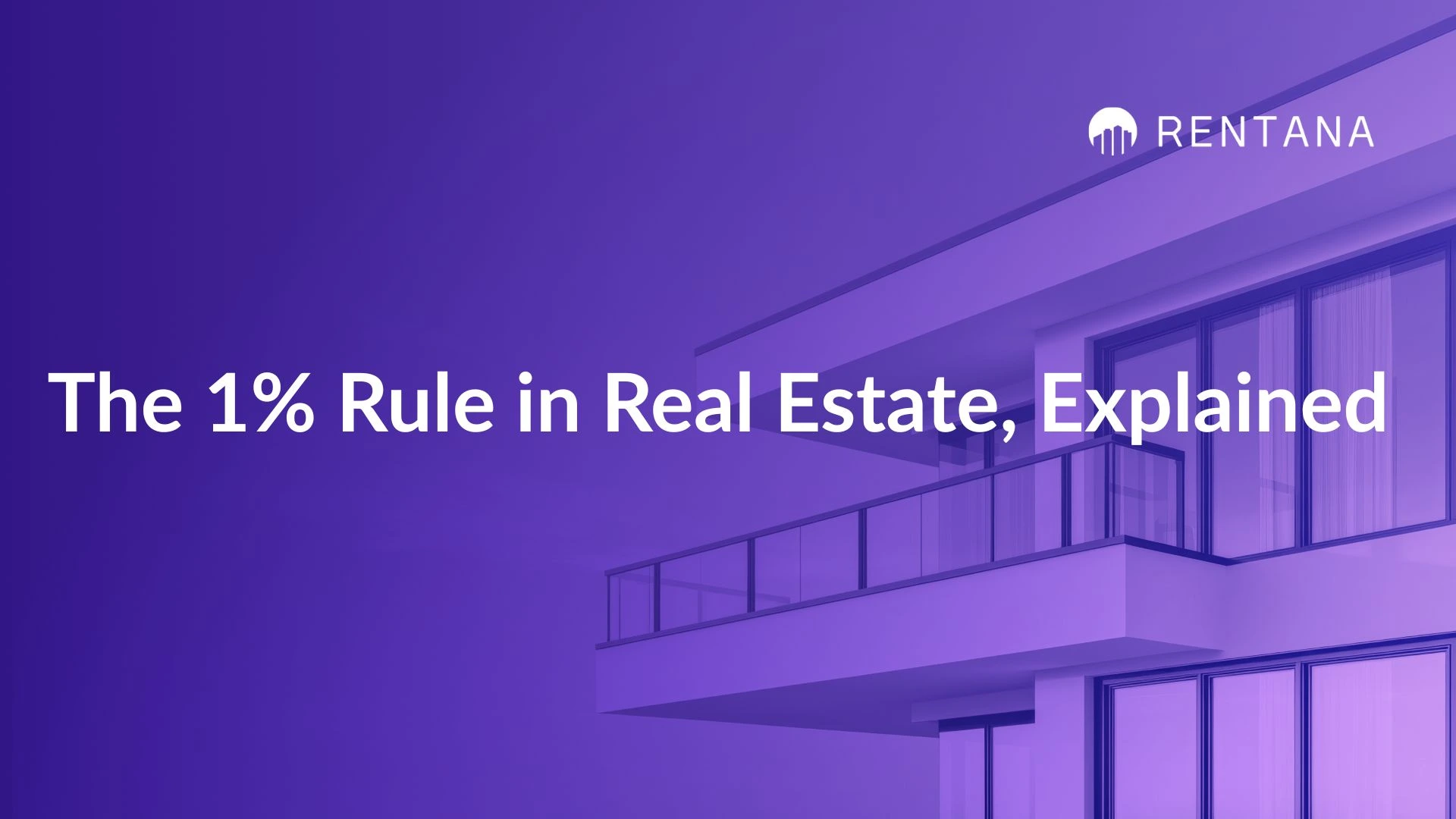




Have you ever heard investors talk about the “1 percent rule” and wondered what it really means? The term pops up often in real estate conversations, especially among those looking for rental properties that actually make money instead of just looking good on paper.
The 1 percent rule is one of the oldest and simplest ways to quickly estimate whether a rental property might be profitable. It helps investors see, at a glance, if the monthly rent will be high enough to cover expenses and generate positive cashflow. According to the U.S. Census Bureau, renter-occupied housing units make up about 31.2% of all occupied units, and many investors use this rule as a quick filter before diving deeper into the numbers.
In this guide, we’ll break down what the 1 percent rule in real estate means, how it works, when it’s useful, and why it’s only the beginning of smart real estate analysis.
Related: 9 Best AI Tools for Real Estate Investors (2025)
The 1 percent rule in real estate is straightforward: the property’s monthly rent should be at least 1 percent of its total purchase price. For example, if a property costs $200,000, the rent should be around $2,000 per month to meet the 1 percent rule
The 1 percent rule in real estate is a quick and simple way investors use to evaluate whether a rental property might generate enough income to be worth buying. If the rent is significantly lower than that, say $1,200 per month, it may not generate enough income to cover expenses like taxes, insurance, maintenance, and loan payments.
This rule doesn’t guarantee profit, but it’s an easy first filter. It helps investors quickly rule out overpriced or low-income properties before spending time on deeper analysis. The rule is especially useful when comparing multiple properties side by side, since it highlights which ones are more likely to provide steady cashflow.
Investors often use it as a starting point, not the final decision. Once a property passes the 1 percent test, they can dive deeper into real expenses, vacancy rates, and financing details to see if it truly performs well.
Related: What is the 2 Percent Rule in Real Estate Investing?

The 1 percent rule in real estate helps investors quickly estimate if a rental property could generate enough income to cover its costs. It’s not a complicated formula, in fact, you can calculate it in seconds.
The Formula:
Monthly Rent ≥ 1% × Purchase Price
This means the rent you collect each month should be equal to or greater than 1 percent of what you paid for the property.
Let’s look at a few simple examples:
Example 1:
You find a property priced at $150,000.
Example 2:
Another property costs $250,000.
The rule acts as a quick filter to decide which properties deserve deeper research. If a property doesn’t meet the 1 percent threshold, it may still be a good investment in certain cases, such as in high-demand areas where property values grow quickly, but it’s a sign to proceed with caution.
Why It’s Useful:
The 1 percent rule in real estate gives you a fast way to compare properties without diving into pages of numbers. It’s especially handy for new investors who want a starting point to screen multiple deals at once. Think of it like a first impression: if a property passes, it’s worth exploring further; if not, it may be too expensive for the income it produces.
Recommended: How To Do A Rental Market Analysis Like a Pro (With AI Tools)
The 1 percent rule isn’t meant to fit every market or property type, but in the right situations, it can be a powerful tool for screening good investments quickly. Here are five scenarios where it works especially well.
The 1 percent rule in real estate tends to work best in areas where property prices are lower but rental demand is strong. These are often smaller cities or suburban areas where homes are affordable, but tenants are plentiful.
Example: A $120,000 duplex renting for $1,200 per unit meets the rule easily, giving investors solid cashflow with room for profit even after expenses.
If your goal is to generate consistent monthly income rather than rely on long-term appreciation, the 1 percent rule is a great fit. It helps identify properties that produce strong rent-to-price ratios, meaning your money works harder each month.
Example: Investors focused on building passive income portfolios often use this rule to find properties that deliver immediate returns rather than waiting for value appreciation.
The 1 percent rule works particularly well for duplexes, triplexes, and fourplexes because they combine affordable purchase prices with multiple rental incomes. Each unit adds to your total rent, making it easier to reach or exceed the 1 percent threshold.
Example: A fourplex purchased for $400,000 that rents for $1,100 per unit brings in $4,400 per month, just above 1 percent, showing good potential for cashflow.
Markets with steady tenant demand and low vacancy rates often meet the 1 percent rule more easily. The constant rental activity keeps income predictable, allowing you to rely on the property to cover costs even during slower seasons.
Example: College towns, job hubs, and commuter cities are great examples. With consistent renters year-round, these areas support stronger rent prices relative to property value.
The 1 percent rule is perfect for narrowing down a long list of potential properties. Instead of analyzing 20 deals in depth, you can apply the rule first to identify which ones are worth your time.
Example: If only five of your twenty listings meet or exceed the 1 percent mark, you’ve already saved hours of research and can focus on those with real potential.
Recommended: Is Multifamily Considered Commercial?

The 1 percent rule is a quick and helpful tool, but it isn’t perfect. Real estate markets are complex, and there are times when this rule doesn’t tell the full story. Here are some of the main limitations to keep in mind before relying on it for big investment decisions.
The 1 percent rule doesn’t account for property taxes, insurance, repairs, or property management fees. These costs can vary widely depending on the location and type of property. A property might meet the rule on paper but still fail to deliver real profits once expenses are added up.
Example: A $200,000 property renting for $2,000 per month meets the rule, but if taxes, insurance, and maintenance total $1,000 monthly, the actual cashflow drops sharply.
In high-cost cities like San Francisco, New York, or Los Angeles, it’s nearly impossible to find properties that meet the 1 percent rule. Prices are high, and rents rarely keep up. In these areas, investors focus more on appreciation potential than strict rent-to-price ratios.
Example: A $900,000 property renting for $4,000 a month only meets 0.44 percent, far below the rule, but long-term value growth could still make it a profitable investment.
The 1 percent rule in real estate assumes you’re paying cash or using simple financing, but in reality, mortgage interest rates and loan terms play a huge role in profitability. Two properties may meet the 1 percent rule, yet one could have higher loan payments that eat into returns.
Example: A property that meets the rule but is financed with a 7 percent interest rate may perform worse than one that doesn’t meet it but has better financing terms.
A property may meet the 1 percent rule because it’s cheap, but that could also mean it’s in poor condition or a weak rental area. Sometimes a low price signals higher risk, more repairs, or unreliable tenants.
Example: A $100,000 house renting for $1,000 per month may look perfect on paper, but if it needs $20,000 in repairs or sits in a neighborhood with high vacancies, it could become a financial headache.
The 1 percent rule is meant to save time, not replace full analysis. It helps identify potential deals but should always be followed by deeper research into cashflow, cap rate, and market conditions.
Example: Many investors use the 1 percent rule to narrow down a list of properties, then use tools like Rentana or spreadsheets to calculate true income and expenses before making a decision.
Read Also: How To Calculate the Value of a Multifamily Property Easily

While the 1 percent rule in real estate is great for quick screening, real estate investing requires more than simple math. Once a property looks promising, you need to dig deeper, and that’s where tools like Rentana come in.
Rentana helps investors go beyond basic rules by combining market data, forecasts, and analytics in one place. Instead of relying on rough estimates, you can see exactly how a property performs under different market conditions and what kind of returns to expect.
Here’s how Rentana helps investors make smarter decisions:
For beginners and experienced investors alike, Rentana takes the guesswork out of evaluating deals. It turns what could be a guessing game into a data-backed process that helps you see risks and opportunities before they happen.
With the right tools, you don’t have to rely solely on simple rules like the 1 percent rule, you can build confidence in every decision you make.
The 1 percent rule is one of the simplest tools in real estate investing, and for good reason, it gives you a quick way to judge if a property is worth a closer look. But while it’s a great starting point, it doesn’t tell the whole story. True success in real estate comes from understanding the numbers behind the rule and using data to make confident decisions.
With tools like Rentana, investors can go beyond basic calculations. You can see market trends, forecast rents, and compare potential investments in minutes. The goal isn’t just to follow a rule it’s to understand your market, your risks, and your returns before you invest.
